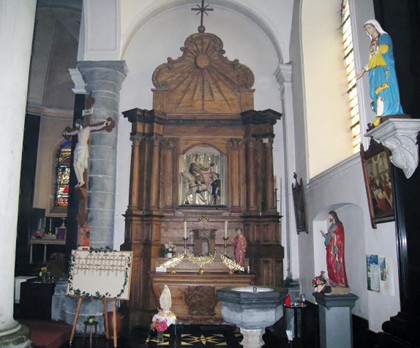Cipher Mysteries reader Keith Walker was intrigued by the Moustier cryptogram story I recently ran here, and decided to try to hunt down the “published report (Moulart, Basècles; Esquisse religieuse) that the ancient altar of St. Martin was sold or offered for sale at Basècles in 1843” mentioned by the NSA. And just so you know what we’re talking about, here’s a picture of the big old altar in question:
What’s good is that he found a scan of the 1910 report by curé Moulart. But what’s confusing is that the relevant passage (near the bottom of page 7) appears to say the opposite of what the NSA article said. Specifically, it says:-
“Dirigeons nos pas vers le bien-amié patron de Basècles, Saint Martin.
Son autel nous est venu de Moustier en 1843. On y voit un rétable avec colonnettes sur lesquelles des corbeilles, d’où s’échappent des flammes, image de la dévotion ardente qui doit animer notre amié dans la prière.”
…which Keith (quite reasonably, I think) translates as…
“Let’s make our way to the beloved patron saint of Basècles, Saint Martin.
His altar came to us from Moustier in 1843. There is an altarpiece with small columns on which baskets, out of which flames are escaping, the representation of the burning/ardent devotion that must animate our souls in prayer.”
So it seems fairly clear that the altar of St. Martin in Basècles actually came from Moustier in 1843, rather than went to there then. Hence I think what we are looking at here is quite probably the altar of St. Martin that was in Moustier before the two new [and apparently enciphered] side-altars were built & installed in 1838. Hence the old altar probably sat around in a shed or similar store for 3 or 4 years before being cleaned up and moved on to Basècles in 1843. Certainly, I think it looks slightly older than Moustier’s two side altars… but probably not a century older, I’d hazard.
Keith wonders whether the Moustier cryptograms may therefore be connected with this altar in some way: though, against that notion, curé Moulart does transcribe lots of other inscriptions from Basècles, and it would probably be fair to expect that if there was something noteworthy about the Basècles St. Martin altar he would have included that too. Even so, absence of evidence is not evidence of absence; so the old Moustier altar might well be worth a closer inspection, if anyone just happens to be passing by the church in Basècles.
Incidentally, Moulart happily mentions a chronogram from the church (p.5) placed above the main door in 1779, though (oddly) the letters he highlights in the text apparently making up the chronogram seem to add up only to 1768:
CUNCTIS HIS OPTANTIBUS
A MANDO PROELATO SURREXI
Here, C + V + C + I + I + I + V [+ S???] + M + D + L + V = 1768.
I’m pretty sure that Moulart forgot to include the “XI” at the end of “SURREXI“, which would bring the total up to 1779 (i.e. the number you first thought of).
PS: there’s a little more history on Basècles church here, including a close-up of the carving of St. Martin on the altar. Note the lack of funky inscriptions!
